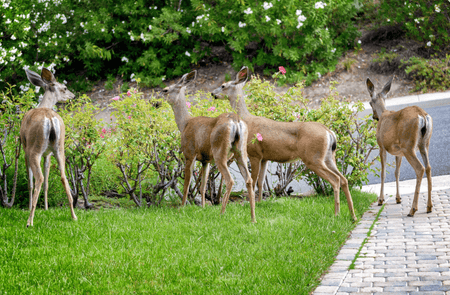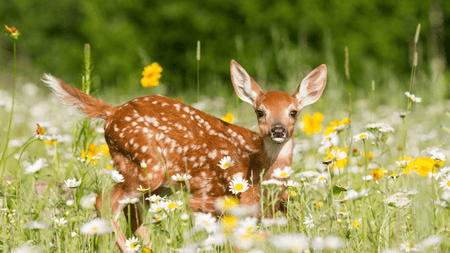Native Plants for Spring Blooms and Pollinators

As you’re planning your native plant garden, you’ll want to create a diversity of plants that will bloom at different times throughout the year. Choose some plants that will bloom early in spring, whereas others will bloom throughout the summer or into fall. Local wildlife and migrating species alike will appreciate your beautiful blooms throughout the seasons when they need it most (so will you and your human neighbors!). The key to gardening for wildlife is planting truly native plants, and that will vary based on where you live.
Native plants are extremely helpful to wildlife and early pollinators in springtime for several reasons:
- Food: Native plants provide a reliable source of food for wildlife in the form of nectar, pollen, seeds, and fruit. Many species of native plants have co-evolved with local wildlife, and the timing and composition of their flowers, fruit, and seeds are perfectly adapted to the needs of local pollinators and other animals.
- Habitat: Native plants provide important habitat for wildlife, including nesting sites, cover, and food sources for caterpillars and other insects. Many species of native plants are also host plants for specific butterfly and moth species, which rely on these plants to complete their life cycles.
- Timing: Native plants tend to bloom and produce fruit and seeds at specific times of year that are synchronized with the needs of local wildlife. For example, many early blooming native plants are important sources of nectar for bees, butterflies, and hummingbirds that emerge from hibernation or migrate north in the spring.
- Adaptation: Native plants are well adapted to local growing conditions, including soil types, rainfall patterns, and temperature ranges. This makes them more resilient in their local environmental conditions than non-native plants, which requiremore water, fertilizer, and pesticides to thrive.
Now that you know how important it is to plant with seasons in mind, here are some of our favorite native perennial plants that will provide spring blooms for you and wildlife to enjoy.

Golden Alexander
Zizia aurea
Blooms May - August
Golden Alexander (Zizia aurea) is a great plant for early spring wildlife! It is a native wildflower that blooms in late spring and early summer, and it is particularly attractive to bees, butterflies, and other pollinators. Golden Alexander is a mainstay in our Spring Bee Buffet native plant collection, which also includes blue wood aster and Jacob’s ladder.
Golden Alexander produces bright yellow flowers in clusters, and these flowers provide an important source of nectar and pollen for early-season pollinators. Golden Alexander is also a host plant for the Black Swallowtail butterfly.
This plant is also relatively easy to grow, and it prefers moist to medium soils in full sun to partial shade. It is a great addition to meadows, prairies, and wildflower gardens, and it can also be used in rain gardens and other wetland areas.

Eastern Columbine
Aquilegia canadensis
Blooms March - July
Aquilegia canadensis, commonly known as red or Eastern columbine, is a superior spring plant for all kinds of wildlife. This native wildflower blooms in late spring to early summer and is a great source of nectar for hummingbirds, butterflies, bees, and other pollinators.
The pinkish red flowers of Aquilegia canadensis are uniquely shaped and hang downward, making them easily accessible to hummingbirds and other nectar-feeding birds. This is why it’s one of the stars of our Hummingbird Heroes native plant collection. The plant's leaves and stems also serve as food for the caterpillars of some moth and butterfly species.
In addition to its value as a food source, Aquilegia canadensis is also a beautiful addition to any garden or landscape. It is a relatively low-maintenance plant that prefers well-drained soil and partial shade.

Foxglove Beardtongue
Penstemon digitalis
Blooms May-July
Foxglove Beardtongue (Penstemon digitalis), also known as Smooth Penstemon, is another top-tier choice for a spring bloom that will attract and support early pollinators and wildlife.
This native North American plant produces beautiful white or pinkish flowers that attract a variety of pollinators, including bees, butterflies, and hummingbirds. The plant's nectar and pollen also provide a food source for other beneficial insects such as predatory wasps, flies, and beetles, which help control pest populations in your garden. You can find foxglove beardtongue in our Monarch Munchables native plant collection, which is beneficial for many pollinators.
In addition, Foxglove Beardtongue's foliage provides cover and nesting sites for birds and other small wildlife. The plant's deep roots help to stabilize soil and prevent erosion, making it a great choice for planting on slopes or in areas with poor soil quality.
Jacob's Ladder
Polemonium reptans
Blooms April-June
Also in our Hummingbird Heroes collection, Jacob's Ladder (Polemonium reptans) is a great buy that blooms in early spring and will support wildlife.
Jacob's Ladder is a herbaceous perennial that produces clusters of small blue or purple flowers in the early spring, attracting pollinators such as bees and butterflies. The plant's foliage also serves as a food source for the larvae of several butterfly species, including the eastern tailed-blue and the silvery blue.
Jacob's Ladder prefers moist, well-drained soil and partial shade, making it a great choice for planting in woodland gardens or along shady edges. It's also relatively low-maintenance, making it a good option for gardeners who want to support wildlife without dedicating a lot of time to garden upkeep.

Pink (Pinxterbloom) Azalea
Rhododendron periclymenoides
Blooms March-May
Pinxterbloom azalea (Rhododendron periclymenoides) is perennial shrub that typically blooms in the spring, usually from mid-April to early May in its native range in the eastern United States.
The showy, fragrant flowers of pinxterbloom azalea attract a variety of pollinators, including bees, butterflies, and hummingbirds, which visit the flowers to collect nectar and pollen. These pollinators help to fertilize the flowers and ensure that the plant can produce seeds, which are a valuable food source for birds and small mammals.
Pinxterbloom azalea also provides cover and nesting habitat for wildlife. The dense foliage and branching structure of the native shrub provide shelter for birds and small mammals, and the leaves can be used as a food source for caterpillars and other insects, which in turn provide food for birds! Win win.

Find Native Plants by Zip Code
We took the guesswork out of planting native. Check your zip to see what ships!

















